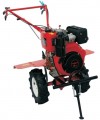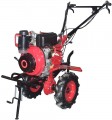Working width
The maximum width of the strip of land processed by the machine in one pass.
The large width makes it easier to work in large open areas, allowing them to be dealt with faster. At the same time, it is easier to deal with bottlenecks and hard-to-reach nooks and crannies with a small working width — a large unit may simply not fit where a smaller one will pass without problems. So it is worth choosing according to this indicator, taking into account the features of the planned work. If we talk about specific numbers, then in the smallest models the capture width
does not exceed 50 cm, in the largest it can be
1 m or more, a value
from 50 to 75 cm can be called average, and
from 75 cm to 1 m — above average.
Also note that some models allow you to expand the processing width by installing additional cutters. However, note that the wider the band, the more power is needed for efficient operation. It is believed that for the full use of the two-wheel tractor, it must produce at least 1 hp. for every 20 cm of width; however, for loose soils and shallow depths, smaller values are sufficient.
Number of blades
The number of cutters that the two-wheel tractor is equipped with. Note that for models with active rototillers (see below), this parameter is not indicated: such attachments are removable, and active rototillers with different performance characteristics can be installed on one unit.
Speaking of quantity, a cutter means a separate "asterisk" of several curved knives installed on the working axis of the unit. The number of such “stars” is selected depending on the processing width that the manufacturer wants to provide: one cutter captures a strip on average from 12 to 18 cm, and several of them are needed for a more or less decent working width.
Motor model
Model of the engine installed in the two-wheel tractor / cultivator. The main performance data of the engine is usually indicated in the general data for the unit. However, knowing the exact name of the motor, you can find more detailed information on it — starting from specific data like torque or revolutions and ending with reviews and reviews. Also, data on the engine model can be useful when searching for spare parts or consumables.
Fuel consumption
The average amount of fuel consumed by the gasoline or diesel engine (see "Engine type") of the cultivator/two-wheel tractor per hour of operation. This value is rather conditional, because depending on the mode of operation, fuel consumption may vary in one direction or another; however, in general, it provides an estimate of the approximate amount of fuel required for a given operating time.
Wheels diameter
The diameter of the main wheels of the two-wheel tractor / cultivator. For flat areas, a small diameter is enough, and for difficult terrain, large wheels are better suited — they are much easier to cope with pits, bumps and various obstacles.

